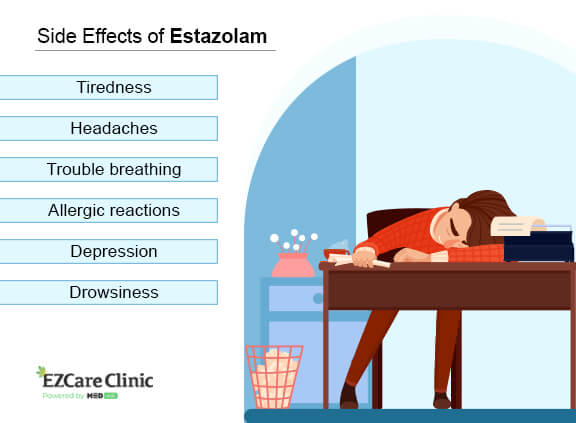The medications listed on this website are provided for informational purposes only. Their inclusion does not guarantee that they will be prescribed to any individual, as treatment decisions are ultimately at the discretion of healthcare providers. This list is not exhaustive, and healthcare providers may prescribe other medications, including non-stimulant options, based on the patient's unique health circumstances and needs.
Estazolam is a medication falling under a class of drugs called benzodiazepines. These medications work by boosting the work of GABA (gamma-amino-butyric acid), an inhibitory neurotransmitter in the brain. When GABA interacts with its receptors, it slows down the normal activity levels in the central nervous system (CNS), resulting in increased sedation and lower anxiety levels. Benzodiazepines enhance this effect, which is why they are also known as CNS depressants.
In this article, let’s review the main features of Estazolam: its uses, how it works, how patients should take it, and what the possible side effects are.
Ask EZCare doctors about what medication will be the most effective for you.
How Estazolam Works
Estazolam works similarly to other benzodiazepines though it has a slightly different chemical structure, which helps increase its efficacy and lowers its side effects. The FDA approved the use of Prosom, Estazolam brand name in the USA, for the treatment of insomnia.
Taking Estazolam will help you sleep better: fall asleep quicker and sleep longer. It also prevents you from waking up frequently at night. It may also be used to treat insomnia associated with anxiety.
Like other benzodiazepines, it could have other off-label uses, but that’s largely at your doctor’s discretion based on condition and other individual factors.
How to Take Estazolam
Estazolam is available only by prescription. Because there is a risk of habit forming leading to addiction, it is classified as a Schedule IV drug, which makes it a controlled substance.
Estazolam tablets are available in doses of 1 mg and 2 mg. If you use Estazolam, keep in mind the following:
- The medication is not intended for long-term use. It is prescribed for short-term treatment, usually for a few nights to four weeks. Your doctor may advise on how to continue treatment after this period. Alert your doctor if you do not observe any improvements between 7 to 10 days.

- The medication should come with an instruction. Ensure you get one from the pharmacist and follow all the guidelines and warnings.
- Follow the doctor’s instructions on the dosage and schedule of taking meds. Usually, adults start with 1 mg taken at bedtime, and the doctor will adjust the dosage as necessary. The dosage starts at 0.5 mg and is adjusted as it may seem necessary for older adults or geriatric use. Generally, Estazolam is not approved for those under 18 years, but the doctor may determine its use and the amount prescribed.
- You can take Estazolam orally with food or without food.
- Do not take the drug unless you have sufficient time for a long sleep of seven to eight hours. If you wake up before that, you risk suffering from short-term memory loss. Further, you should only take the medication when you are about to sleep as you may fall asleep quickly, and you want to be safe in your bed with nothing requiring your attention.
Consult with a doctor to know more about the contraindications and side effects of Estazolam.
Warnings for Using Estazolam for Sleep
Estazolam is a strong hypnotic and sedative, and you must be aware of any potential risks. Adhere to the following warnings and inform your doctor if you have worrying symptoms. The main warnings are:
- You should not take this medicine during pregnancy as it is not safe for the child. There is a risk it could harm the baby resulting in congenital disabilities. Inform your doctor immediately should you get pregnant while on medication.
- It is not yet known if Estazolam passes into milk and if it can harm a nursing baby. It is, however, not recommended if you are breastfeeding, so you should inform your doctor if you are for further guidance.
- To ensure your use of Estazolam is safe, inform your doctor if you have any medical conditions, especially kidney or liver disease, chronic obstructive pulmonary disease (COPD), asthma, sleep apnea, and other breathing conditions. You should also mention if you have a depression history.
- Estazolam can be habit-forming. Therefore, you should not use it longer or at higher amounts than prescribed to avoid overdose.
- The medication can also cause anaphylaxis, an allergic reaction that can be life-threatening. Anaphylaxis requires urgent medical attention. When using this medication, you should seek immediate treatment if you experience hives, mouth, hands, and face swelling or difficulty breathing.
Side Effects of Estazolam
Estazolam’s side effects can either be severe or mild. Individual factors may also influence the intensity and kind of side effects one experiences.
Mild side effects include:
- Some drowsiness or mild dizziness
- Difficulty in concentration
- Tiredness
- Headaches
- Slowed motor function
Severe side effects include:
- Allergic reactions

- Depression
- Extreme lethargy
- Trouble breathing
- Addiction
- Skeletal and neuromuscular weakness
Conclusion
Estazolam is an effective short-term treatment for insomnia. It should, however, be taken only as prescribed by the doctor and not as a recreational pill. You should also follow medical recommendations on stopping it since abrupt stopping will result in withdrawal symptoms. Use it as directed, and it will help you get better sleep.
Expert help for mental health issues.
Get treatment from licensed healthcare professionals.



